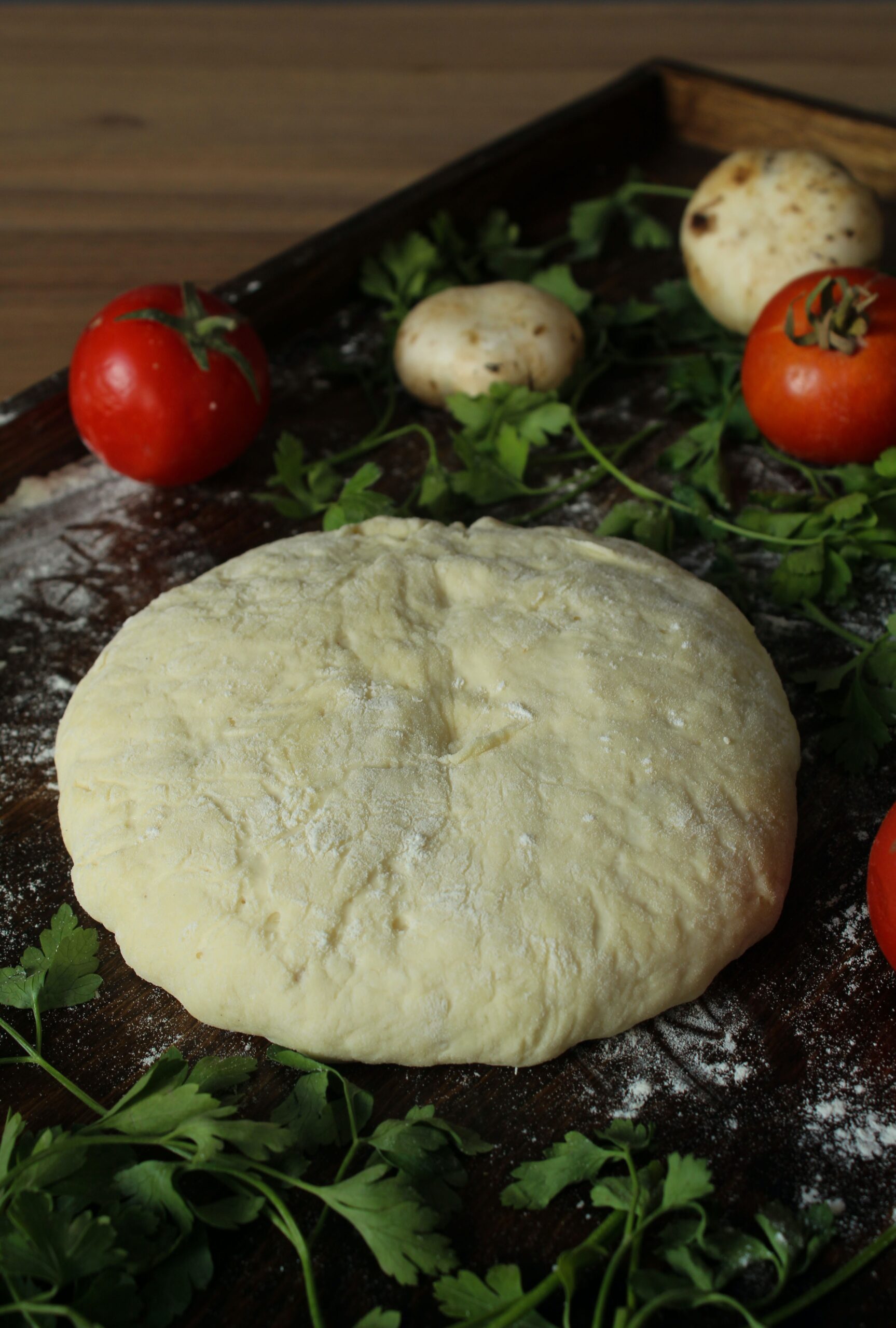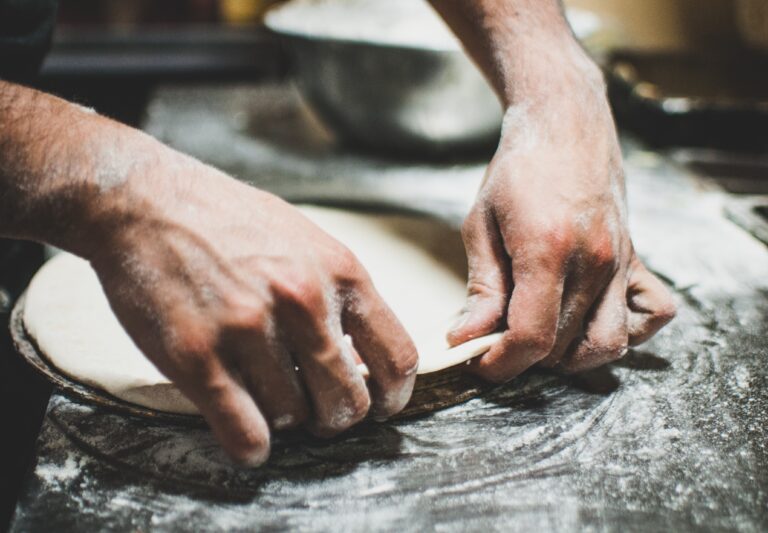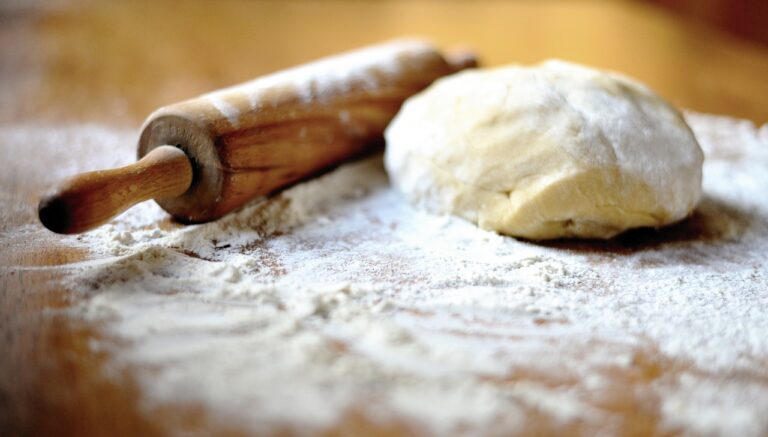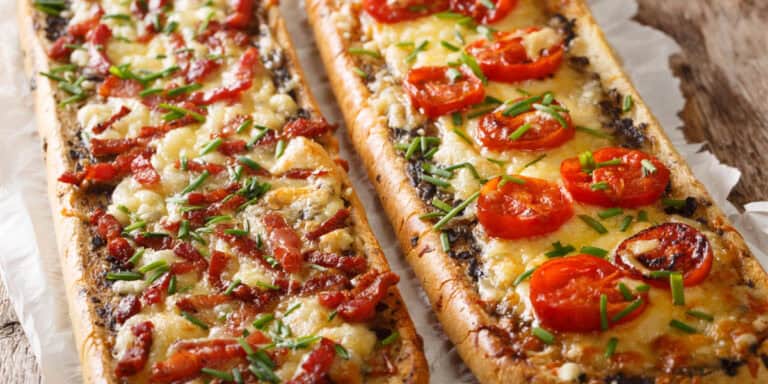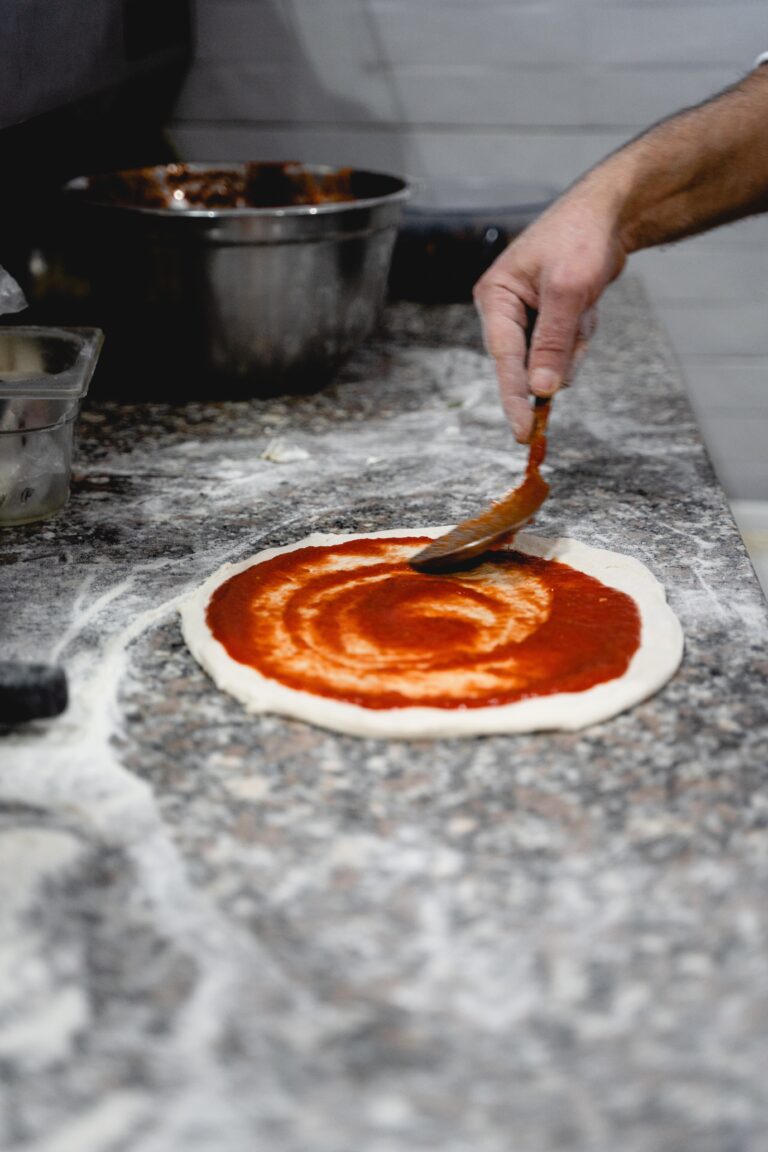Wheat Pizza Crust Recipe
Are you tired of the same old pizza crust? Well, look no further! In this article, we’ll show you how to make a delicious wheat pizza crust that will take your homemade pizzas to a new level.
Using whole wheat flour adds a nutty flavour and packs in extra nutrients. So get ready to impress your friends and family with this innovative twist on a classic favourite.
Let’s get started!
Why Choose Wheat Pizza Crust?
There are several reasons why you should choose wheat pizza crust. Not only does it offer a host of advantages over traditional crusts, but it also packs a punch regarding nutritional value. Wheat pizza crust adds a unique twist to your favourite dish with its earthy and nutty flavour.
One of the most significant advantages of wheat pizza crust is its higher fibre content. Compared to regular pizza dough, the wheat crust is made from whole grains that retain all parts of the grain, including the bran and germ. This means you get more fibre in every bite, keeping you fuller for longer and aiding digestion.
In addition to its fibre content, wheat pizza crust is rich in essential nutrients such as vitamins B1, B2, and B3, as well as minerals like magnesium and zinc. These nutrients play a vital role in maintaining overall health and well-being-.
Furthermore, wheat flour has a lower glycemic index than refined white flour used in traditional pizza dough. This means it causes a slower rise in blood sugar levels after consumption. For those watching their blood sugar levels or managing diabetes, this can be an essential factor to consider.
So next time you’re craving a slice of deliciousness with added health benefits, choose wheat pizza crust. It’s innovative and packed with nutritional value that will satisfy your taste buds and nourish your body.
The Benefits of Using Whole Wheat Flour
Using whole wheat flour in your pizza dough can provide numerous health benefits. Not only does it add a nutty flavour and hearty texture to your crust, but it also packs a powerful punch of nutrition. Whole wheat flour is made from the entire grain, including the bran, germ, and endosperm, which means it retains all of its natural fibre and nutrients.
One key benefit of using whole wheat flour is its high fibre content. Fiber plays a crucial role in digestion, helping to regulate blood sugar levels and promote a feeling of fullness. This can aid in weight management and prevent overeating.
Additionally, whole wheat flour is rich in essential vitamins and minerals such as magnesium, zinc, and B vitamins. These nutrients are vital for maintaining overall health and well-being.
Essential Ingredients for a Perfect Wheat Pizza Crust
Key ingredients like yeast and olive oil are essential for perfect, flavorful pizza dough. These ingredients not only contribute to the taste and texture of the crust but also provide health benefits. Here’s why:
-
Yeast:
-
Adds a lightness and chewiness to the dough.
-
It contains B vitamins, which support metabolism and brain function.
-
Olive Oil:
-
Provides heart-healthy monounsaturated fats and antioxidants.
When it comes to alternative flours for your wheat pizza crust, several options can add nutritional value and unique flavours:
-
Whole Wheat Flour:
Retains more fibre, vitamins, and minerals compared to refined white flour.
-
It adds a nutty taste to your crust.
-
Almond Flour:
-
Gluten-free option with a slightly sweet taste.
-
Rich in healthy fats, protein, vitamin E, and magnesium.
Step-by-Step Instructions for Making Wheat Pizza Crust
Wheat flour is a great option for making a healthier pizza crust. It provides numerous health benefits and adds a delicious nutty flavour to your dough.
In this discussion, we’ll explore the various health benefits of wheat and share some tips for kneading dough to help you achieve the perfect texture for your homemade pizza crust.
So, let’s dive in and discover how incorporating wheat into your recipe can enhance your pizza’s taste and nutritional value!
Health Benefits of Wheat
You can enjoy the health benefits of wheat by using its flour for your homemade pizza crust.
Wheat is a nutritious grain that provides essential nutrients like fibre, protein, and vitamins. It is known to support digestive health, promote heart health, and help with weight management. The high fibre content in wheat flour aids in digestion and keeps you feeling full for longer. Additionally, the protein found in wheat promotes muscle growth and repair.
Various alternatives to conventional wheat flour are available, such as whole wheat flour, spelled flour, or even gluten-free flour like almond or rice flour. These alternatives can offer similar nutritional benefits while catering to specific dietary needs. So, experiment with different types of wheat flour to create a healthier version of your favourite pizza crust!
Tips for Kneading Dough
Kneading dough helps develop gluten, giving baked goods their desired texture. But mastering this mixing technique can be a bit tricky. Don’t worry; we’ve got you covered with some troubleshooting tips to ensure your dough comes out perfect every time:
-
Time it right: Under-kneaded dough will have a dense and rugged texture, while over-kneaded dough can dry and crumbly your baked goods. Aim for a smooth and elastic consistency.
-
Technique matters: Use the heel of your hand to push the dough away from you, then fold it back over itself. Repeat this motion until the dough is properly kneaded.
-
Give it some rest: Letting the dough rest for 10-15 minutes after kneading allows the gluten to relax and makes it easier to work with during shaping.
-
Adjust as needed: If your dough feels too sticky, add a little flour; if it’s too dry, add water gradually until you reach the right consistency.
With these mixing techniques and troubleshooting tips in mind, you’ll be well on your way to creating amazing breads, pastries, and pizzas! Get ready to innovate in the kitchen like never before!
Tips and Tricks for a Flawless Wheat Pizza Crust
Preheating your oven to the recommended temperature is essential for a flawless wheat pizza crust. This ensures that the crust bakes evenly and achieves the perfect crispness.
But there are more tips and tricks for improving the flavour and texture of your wheat pizza crust.
One way to add variety to your wheat pizza crust is by experimenting with different flavour variations. For an aromatic twist, you can add herbs like rosemary or thyme to the dough. For a cheesy delight, add grated Parmesan or shredded mozzarella directly into the dough mixture. And if you’re feeling adventurous, why not sprinkle some chilli flakes or garlic powder for an extra kick?
But what if your wheat pizza crust doesn’t turn out as expected? No worries! Here are some troubleshooting tips:
-
If your crust turns too dense, try using bread flour instead of all-purpose flour. Bread flour has a higher gluten content, which helps create a lighter and chewier texture.
-
If your crust is too dry, consider increasing the olive oil in the recipe or adding water until you achieve the desired consistency.
-
If your crust sticks to the pan, generously grease it before placing the dough on it.
Finally, if your crust lacks flavor, don’t be afraid to experiment with different seasonings and spices until you find what best suits your taste buds.

Tasty and Healthy Topping Ideas for Wheat Pizza
Now that you’ve mastered making a flawless wheat pizza crust, it’s time to explore the world of toppings!
Wheat pizza crust opens up a new realm of flavours and textures, so get ready to tantalize your taste buds with these delicious and healthy topping ideas.
Here are four unique wheat pizza topping combinations that will take your homemade pizzas to the next level:
-
Mediterranean Delight: Spread a layer of roasted garlic hummus on your wheat crust, then top it with sliced cherry tomatoes, kalamata olives, feta cheese crumbles, and fresh basil leaves. The combination of tangy olives and creamy hummus will transport you straight to the shores of Greece.
- BBQ Chicken Fiesta: Brush your crust with barbecue sauce instead of traditional tomato sauce. Add chicken breast chunks, red onions, bell peppers, and smoked gouda cheese. This smoky and savoury delight will satisfy all your cravings.
-
Pesto Veggie Paradise: Instead of tomato sauce, spread a generous amount of pesto on your wheat crust. Top it off with sautéed mushrooms, zucchini ribbons, roasted red peppers, and mozzarella cheese for freshness in every bite.
Thai Peanut Sensation: Swap out tomato sauce for a peanut butter and soy sauce mixture as the base. Layer on grilled chicken strips, shredded carrots, bean sprouts, chopped peanuts, and cilantro for an explosion of Thai flavours that will leave you craving more.
With these creative wheat pizza crust alternatives and unique topping combinations in your culinary arsenal, you’ll never get bored with homemade pizza night again.
Baking and Serving Suggestions for Wheat Pizza Crust
If you want a flavorful twist on your homemade pizza, try experimenting with different baking and serving suggestions.
Baking techniques can significantly enhance the taste and texture of your wheat pizza crust. One option is to preheat your oven to its highest temperature and bake the crust directly on a preheated pizza stone or baking sheet. This will give you a crispy, golden crust reminiscent of brick oven-baked pizzas.
Another technique to consider is par-baking the crust before adding your toppings. Bake the dough for 5-7 minutes until it’s lightly golden and set. Then, please remove it from the oven, add your desired toppings, and return it to the oven for final baking. This method allows the toppings to cook evenly while ensuring that your crust doesn’t become soggy.
When it comes to alternative crust options, there are plenty of exciting possibilities. How about trying a cauliflower crust? Made from grated cauliflower mixed with eggs and cheese, this low-carb option is both delicious and nutritious. For those with dietary restrictions, you can also experiment with gluten-free options like almond flour or chickpea flour crusts.
In terms of serving suggestions, don’t be afraid to get creative! Cut your pizza into bite-sized squares for an appetizer-style presentation, or roll up individual slices for a unique handheld experience. And remember, always serve your freshly baked pizza hot out of the oven – that’s when it’s at its absolute best!
So, unleash your culinary creativity by exploring different baking techniques and alternative crust options. Your taste buds will thank you!
Frequently Asked Questions About Wheat Pizza Crust
One common question is whether wheat pizza crust can be made gluten-free. While it may seem like a contradiction, there are alternative pizza crust options that can satisfy those who avoid gluten.
Gluten-free pizza crusts are typically made with alternative flours such as almond flour, coconut flour, or cauliflower. These alternatives provide a delicious and nutritious option for those who enjoy gluten-free pizza.
When comparing wheat crust to other types, it’s essential to consider the taste, texture, and nutritional value. The wheat crust has a classic flavour that many love—slightly nutty and chewy. When appropriately baked, it also has a nice crunch.
Conversely, alternative crusts offer unique flavors and textures. Almond flour adds a subtle sweetness, while coconut flour provides a light and fluffy texture.
Regarding nutrition, wheat crust is higher in carbohydrates than alternative options like cauliflower or almond flour crusts, which are lower in carbs and calories. These alternatives might be worth exploring if you’re following a specific diet or watching your carb intake.
So yes, while traditional wheat pizza crust cannot be made gluten-free, plenty of alternative options that cater to diverse dietary needs and preferences are available. Don’t hesitate to try something new and embark on an innovative culinary journey with these alternative pizza crusts!
